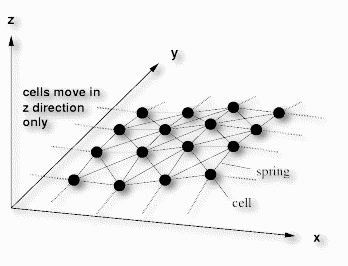
Conceptual Overview

Conceptual Overview

Cell Attributes
Tao's Cellular Material
Tao is based around the notion of building complex vibrating structures from simpler acoustic building blocks. In order to realise this goal a general purpose adaptable acoustic material is provided. The material consists of point masses arranged in a regular grid pattern and connected together with springs. The overall structure of the material is shown in figure *.

Each point mass or cell maintains a set of state variables for its position, velocity, mass, etc., and the overall state is updated in discrete time steps or ticks according to rules which take into account a cell's own state and the states of its immediate neighbours. More specifically a cell's spring connections to its neighbours exert forces on the cell and from these forces Newton's laws of motion can be used to calculate the acceleration and velocity of the cell.
Note that the cells are constrained to have one degree of freedom (in the direction of the z axis). This has two practical advantages:
- It makes the calculations involved in animating the material simpler.
- It also makes it a simple matter to generate time varying waveforms from the vibrations in the material since all cells will vibrate about a fixed zero reference point at z=0 so long as at least one cell is fixed at that position.
One question which has often been asked in relation to Tao's cellular material is: `have you experimented with 3D blocks of material?'. The answer to this question is no, for the following reasons. Firstly, the computational expense of such instruments would be prohibitive, and secondly, although the restriction of working with 2D instruments may at first seem like a limitation, in practice it doesn't significantly affect Tao's ability to produce an wide variety of interesting sounds.

Conceptual Overview

Conceptual Overview

Cell Attributes